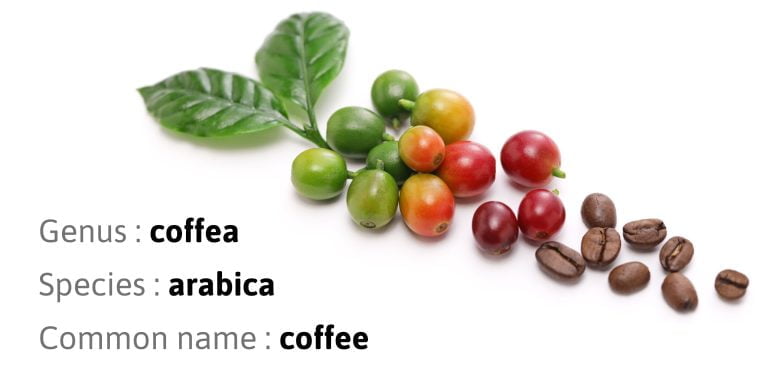Introduction about coffea arabica
Arabica coffee, known scientifically as Coffea arabica, is the most popular coffee species, cherished for its smooth, complex flavors and aromatic qualities. It accounts for over 60% of global coffee production. The Arabica coffee plant’s journey from Ethiopia’s highlands to coffee farms worldwide is a captivating tale of cultural and economic exchange.
A recent study published in Nature Genetics has shown that C. Arabica formed from the natural hybridization between Coffea canephora and Coffea eugenioides, from which it received two sets of chromosomes from each parent. Researchers indicate that C. Arabica was formed between approximately 610,000 and 1 million years ago.

Origins and Early Journey
Coffea arabica originates from Ethiopia, where the genetic diversity of this species is most abundant. Historians believe (Montagnon et al., 2022) the first coffee beans were taken from the coffee forests in southwestern Ethiopia and brought to Yemen, where coffee began to be cultivated as a crop. The farmers and breeders in Yemen selected and created numerous Arabic coffee varieties, each with unique performance and adaptation to local conditions.

Recent genetic tests have shed light on the origins of the leading coffee seeds transported from Ethiopia to Yemen. The tests confirmed that these seeds were genetically related to the Bourbon and Typica varieties (Montagnon et al., 2021).
Subsequently, the descendants of these Bourbon and Typica seeds were disseminated globally from Yemen, laying the foundation for most modern coffee Arabica cultivation worldwide. This discovery provides valuable insights into the historical journey and genetic lineage of the coffee varieties we enjoy today.

Cultivation Practices of coffea arabica
Cultivating the arabica coffee plant requires specific conditions for optimal growth. Coffee Arabica thrives in high altitudes (1,200 to 1,800 meters ASL), with temperatures ranging from 15 to 24°C. It requires a balanced mix of sunlight and shade, thriving best in well-drained, fertile soil. Proper cultivation practices involve regular pruning, pest and disease management, and careful harvesting.
In regions like Ethiopia, coffee is often grown in traditional agroforestry systems, which preserve biodiversity and provide a sustainable environment. In other coffee-producing countries, modern agricultural techniques are employed to maximize yield and quality.
Coffea Arabica Flavor Profile
Arabic coffee is prized for its diverse flavour, from fruity and floral to nutty and chocolate. The specific taste of arabica coffee depends on factors such as the coffee variety, growing conditions, and processing methods.

Main Types of Arabica Coffee
Ethiopian Landrace:
Landraces are traditional, locally adapted varieties that have been domesticated over time through adaptation to their natural and cultural environments. In the case of coffee, most landrace varieties originate from the forests of Ethiopia, where Coffea arabica evolved. These landraces are associated with high cup quality but typically have lower yields.
Bourbon and Typica Group:
These two groups form the foundation of most Arabic coffee production worldwide today. The Dutch introduced Seeds from Yemen to India and Java, leading to the Typica lineage. Seeds from Yemen were also brought to Bourbon Island, giving rise to the Bourbon lineage.
Typica and Bourbon plants spread to Europe, the Americas, and Africa through colonial trade routes in the 18th and 19th centuries. While known for high cup quality, they are susceptible to significant coffee diseases. In Brazil, which produces 40% of the world’s coffee, 97.55% of coffee cultivars are derived from the Typica and Bourbon varieties.
Introgressed (Catimor/Sarchimor):
Introgressed varieties possess genetic traits from another species, mainly Coffea canephora (Robusta).
In the 1920s, a natural hybrid of C. arabica and C. canephora in East Timor created the Timor Hybrid, which is highly resistant to coffee leaf rust. Crosses of the Timor Hybrid with high-yielding dwarf Arabica varieties like Caturra and Villa Sarchi led to the creation of Catimors and Sarchimors.
These groups contain many different varieties with similar parentage. They are crucial for farmers facing coffee leaf rust and coffee berry disease. However, they traditionally have lower cup quality than other varieties.

A Note About Coffee Leaf Rust Resistance
A fungal disease caused by Hemileia vastatrix called Coffee leaf rust poses a significant threat to global coffee production, resulting in defoliation and severe crop losses. Over the past three decades, the development of introgressed Arabica varieties resistant to rust provided a crucial safeguard for many producers.
However, resistance is declining in many regions. World Coffee Research is actively working to address this issue by monitoring rust outbreaks and resistance breakdowns, ensuring farmers can access the most effective and resilient coffee varieties. Their efforts aim to maintain the sustainability and productivity of the coffee industry worldwide.

F1 Hybrids
F1 hybrids result from crossing two genetically distinct Arabica parents, creating offspring with high cup quality, yield, and disease resistance. However, seeds from F1 hybrid plants will not have the same characteristics as the parent plants.
They should be reproduced through clonal propagation to maintain desired traits. Farmers should purchase F1 hybrid seedlings from trusted nurseries.

Sustainability and Future Challenges
The cultivation of the arabica coffee plant faces significant challenges from climate change, which threatens its ideal growing conditions. Rising temperatures, altered rainfall patterns, and increased pest and disease outbreaks pose tremendous risks to coffee production.
To address these challenges, coffee researchers and organizations are developing more resilient coffee varieties and promoting sustainable farming practices. Efforts include breeding programs to create high-yielding, disease-resistant Arabica varieties that can withstand changing climates.
Sustainable practices such as shade-grown coffee, organic farming, and agroforestry systems are also being promoted to ensure the long-term viability of coffee cultivation.
The Economic and Cultural Impact of Arabica Coffee
Arabica coffee has a profound economic and cultural impact on many regions worldwide. Coffee farming is a significant source of income and employment in countries like Brazil, Vietnam, Colombia, and Ethiopia.
The coffee industry supports entire communities and contributes significantly to national economies.

Culturally, Arabic coffee holds a special place in people’s daily lives and traditions worldwide. The traditional coffee ceremony in Ethiopia is a significant social and cultural event. In Italy, espresso is integral to the country’s coffee culture. Coffeehouses have historically been centres of social interaction and intellectual exchange, from the Ottoman Empire to modern-day cities.
This post contains affiliate links, meaning I may earn a commission if you make a purchase through these links, at no additional cost to you. As an Amazon Associate, I earn from qualifying purchases. I only recommend products I genuinely believe will add value.

Lavazza Espresso Whole Bean Coffee, Medium Roast, 100% Arabica, 2.2 lb Bag
- INTENSITY AND ROAST: With a 5/10 intensity, this fragrant medium roast offers a …
- BLEND: A 100% Arabica, naturally caffeinated blend sourced from South America an…
- AROMATIC NOTES: Florals and fruit
- PREPARATION: Ideal for espresso machines, moka pot, drip coffee machines, or Fre…
- LAVAZZA ESPRESSO: A 2.2 lb whole bean coffee bag ideal for espresso or drip prep…
Conclusion
The journey of Coffea arabica from the Ethiopian highlands to coffee cups worldwide is a remarkable story of exploration, cultivation, and cultural exchange. With its rich history, diverse flavor profiles, and significant economic and cultural impact, Arabica coffee remains a beloved beverage worldwide.
Understanding the complexities of the arabica coffee plant, from its genetic origins to its modern-day challenges, deepens our appreciation for every cup of coffee we enjoy. Continuous research and sustainable practices are essential to preserving the legacy and future of Arabica coffee. Whether you’re a seasoned coffee connoisseur or a casual drinker, the story of arabica coffee is a testament to this exceptional drink’s enduring appeal and global significance.
Arabica Coffee FAQ
What percentage of the world’s coffee production is Arabica?
Coffea arabica is the dominant species in the global market, accounting for over 60% of worldwide coffee production, valued for its smooth, complex flavors and aromatic qualities.
Where did Arabica coffee originally come from?
Arabica coffee originated in the highlands of Ethiopia, where it was first discovered, with its genetic diversity still most abundant in this region.
What are the two foundational groups of Arabica coffee?
The two foundational genetic groups that form the basis for most modern Arabica cultivation worldwide are the Bourbon and Typica lineages.
What is the main threat to Arabica coffee production?
The main threat to Arabica production is the fungal disease known as Coffee Leaf Rust (Hemileia vastatrix), which causes defoliation and severe crop losses, alongside the challenges posed by climate change.
What are F1 Hybrids in Arabica coffee?
F1 Hybrids are created by crossing two genetically distinct Arabica parents to produce offspring with an optimal combination of high cup quality, high yield, and disease resistance.





